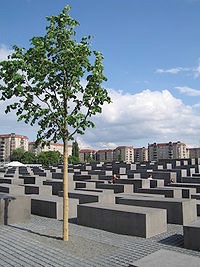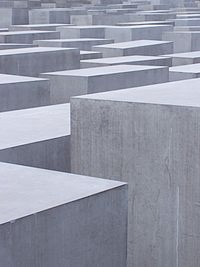Berlin, Germany
Memorial to the Murdered Jews of Europe

From Wikipedia, the free encyclopedia
Visitors walking among the stelae
The Memorial to the Murdered Jews of Europe[1] (German: Denkmal für die ermordeten Juden Europas), also known as the Holocaust Memorial (German: Holocaust-Mahnmal), is a memorial in Berlin to the Jewish victims of the Holocaust, designed by architect Peter Eisenman and engineer Buro Happold. It consists of a 19,000 m2 (4.7-acre) site covered with 2,711 concrete slabs or "stelae", arranged in a grid pattern on a sloping field. The stelae are 2.38 m (7 ft 10 in) long, 0.95 m (3 ft 1 in) wide and vary in height from 0.2 to 4.8 m (7.9 in to 15 ft 9.0 in). According to Eisenman's project text, the stelae are designed to produce an uneasy, confusing atmosphere, and the whole sculpture aims to represent a supposedly ordered system that has lost touch with human reason. A 2005 copy of the Foundation for the Memorial's official English tourist pamphlet, however, states that the design represents a radical approach to the traditional concept of a memorial, partly because Eisenman did not use any symbolism. However, observers have noted the memorial's resemblance to a cemetery.[2][3][4] An attached underground "Place of Information" (German: Ort der Information) holds the names of all known Jewish Holocaust victims, obtained from the Israeli museum Yad Vashem.
Building began on April 1, 2003 and was finished on December 15, 2004. It was inaugurated on May 10, 2005, sixty years after the end of World War II, and opened to the public two days later. It is located one block south of the Brandenburg Gate, in the Friedrichstadt neighborhood. The cost of construction was approximately €25 million.
The memorial has attracted some controversy, and was described by Ignatz Bubis, the then leader of the German Jewish community, as unnecessary.[citation needed]
History
German journalist Lea Rosh was the driving force behind the memorial. In 1989, she founded a group to support its construction and to collect donations. With growing support, the Bundestag passed a resolution in favour of the project.
First competition
The Memorial
In April 1994 a competition for its design was announced in Germany's major newspapers. Twelve artists were specifically invited to submit a design and given 50,000 DM (€25,000) to do so. The winning proposal was to be selected by a jury consisting of representatives from the fields of art, architecture, urban design, history, politics and administration. It included a few minor celebrities such as Frank Schirrmacher, co-editor of the Frankfurter Allgemeine Zeitung. The deadline for the proposals was October 28. On May 11, an information colloquium took place in Berlin, where people interested in submitting a design could receive some more information about the nature of the memorial to be designed. Ignatz Bubis, the president of the Central Council of Jews in Germany, and Wolfgang Nagel, the construction senator of Berlin, spoke at the event.[5]
Before the deadline, the documents required to submit a proposal were requested over 2600 times and 528 proposals were submitted. The jury met on January 15, 1995 to pick the best submission. First, Walter Jens, the president of the Akademie der Künste was elected chairman of the jury. In the following days, all but 13 submissions were eliminated from the race in several rounds of looking through all works. As had already been arranged, the jury met again on March 15. 11 submissions were restored to the race as requested by several jurors, after they had had a chance to review the eliminated works in the months in between the meetings. Two works were then recommended by the jury to the foundation to be checked as to whether they could be completed within the price range given. One was designed by a group around the architect Simon Ungers from Hamburg; it consisted of 85x85 m square of steel girders on top of concrete blocks located on the corners. The names of several extermination camps would be perforated into the girders, so that these would be projected onto objects or people in the area by sunlight. The other winner was a design by Christine Jackob-Marks. Her concept consisted of 100x100 m large concrete plate, 7 meters thick. It would be tilted, rising up to 11 meters and walkable on special paths. The names of the Jewish victims of the Holocaust would be engraved into the concrete, with spaces left empty for those victims whose names remain unknown. Large pieces of debris from Massada, a mountaintop-fortress in Israel, whose Jewish inhabitants killed themselves to avoid being captured or killed by the Roman soldiers rushing in, would be spread over the concrete plate. These plans would eventually be vetoed by Chancellor Helmut Kohl.[citation needed]
Chosen design
Peter Eisenman and the artist Richard Serra collaborated on a plan that emerged as the winner of the next competition in November 1997. Richard Serra, however, quit the design team soon after, citing personal and professional reasons. On June 25, 1999, a large majority of the Bundestag decided in favor of Eisenman's plan, modified by attaching a museum, or "place of information," designed by Berlin-based exhibition designer Dagmar von Wilcken. Across the street from the northern boundary of the memorial is the new Embassy of the United States in Berlin, which opened July 4, 2008. For a while, issues over setback for U.S. embassy construction impacted the memorial. Construction of the memorial started in April 2003.
Completion and opening[
On December 15, 2004, the memorial was finished. It was dedicated on May 10, 2005, as part of the celebration of the 60th anniversary of V-E Day and opened to the public two days later. Holocaust survivor Sabina Wolanski was chosen to speak on behalf of the six million dead. In her speech she noted that although the Holocaust had taken everything she valued, it had also taught her that hatred and discrimination are doomed to fail. She also emphasised that the children of the perpetrators of the Holocaust are not responsible for the actions of their parents.[6]
It is estimated that some 3.5 million visitors entered the memorial in the first year it was open, or about 10,000 every day. About 490,000 people also visited the underground Information Center, 40% of them non-Germans. The foundation operating the memorial considered this a success; its head, Uwe Neumärker, called the memorial a "tourist magnet". There was also vandalism, however: swastikas were drawn on the stelae on five different occasions in this first year.[7]
My Images 2012





